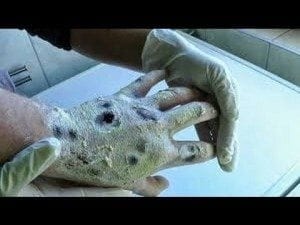Funtabulously Frivolous Friday Five 121
Just when you thought your brain could unwind on a Friday, you realise that it would rather be challenged with some good old fashioned medical trivia FFFF, introducing the Funtabulously Frivolous Friday Five 121
Question 1
The Valsalva manoeuvre. We’re all familiar with it for treating SVT, but what was it initially used for?
Reveal the funtabulous answer
Initially used to expel pus from the middle ear.
Question 2
Name one of two (unrelated) drugs which are known as the “zombie drug” due to their effects.
Reveal the funtabulous answer
Krokodil
Krokodil ordesomorphine (an injectable opioid of abuse), made headlines in 2013 as the “zombie drug” due to the number of soft tissue infections/necrosis around injection sites and the ‘zombie-like’ behaviour of addicts. [Reference]
Tetradotoxin
isolated from many venomous animals, including the pufferfish – was suggested as the ingredient in Haitian voodoo rituals responsible for creating “voodoo zombies”, although there has been limited evidence to support this. [Reference]
Question 3
Let’s go back to the basics for a second. How many times a day do you chart a medication to be given as “stat” or ask for something “stat“? What is “stat” short for and what does it mean?
Question 4
Peter Chamberlen (1560-1631) is credited with the creation of what medical assistive device?
Reveal the funtabulous answer
Obstetric forceps
This invention, which is still used today, was initially a closely guarded secret and would be brought to the patients house in a box with gilded carvings. The patient would be blindfolded so that she would not see them.
- Dunn PM. The Chamberlen family (1560–1728) and obstetric forceps. Archives of Disease in Childhood – Fetal and Neonatal Edition 1999;81:F232-F234.
Question 5
William Coley (1862-1936) created Coley’s toxins in the late 1800’s. What was the toxin used to treat?
Reveal the funtabulous answer
Coley created a mixture of toxins from Streptococcus or Serratia species (or the organisms themselves) as a treatment for malignancy (particularly sarcomas)
Essentially an immunotherapeutic agent, well before its time. [Reference]
- Coley WB. Contribution to the knowledge of sarcoma. Ann Surg. 1891;14:199–220.
- Coley WB. The treatment of malignant tumors by repeated inoculations of erysipelas: with a report of ten original cases. American journal of the medical sciences. 1893; 105: 487–511.
- McCarthy EF. The Toxins of William B. Coley and the Treatment of Bone and Soft-Tissue Sarcomas. Iowa Orthop J. 2006;26:154-8.

FFFF
Funtabulously Frivolous Friday Five
Medical Registrar fascinated by the quirky history of medicine and those crazy microbes.



